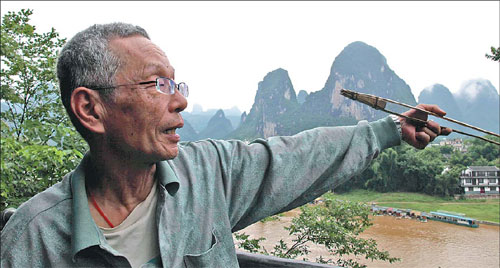 |
|
Japanese Katsuyuki Hayashi stands on top of Laozhai Hill in Yangshuo county, the Guangxi Zhuang autonomous region. Photos by Huo Yan / China Daily |
He had arrived in China for an international symposium, but he loved what he saw so much he decided to stay. Now, he plays host to other visitors from abroad, including his fellow Japanese. Huo Yan in Guangxi and Gan Tian in Beijing piece together his story.
Katsuyuki Hayashi is far from home, but where he is now, he has become a local celebrity. He was the first foreigner to have opened an inn at the foot of Laozhai Hill, in Xingping town, Yangshuo county, in the Guangxi Zhuang autonomous region.
His story has become a local legend. Hayashi, known to his neighbors as Lin Kezhi, came to Xingping in 1996, to attend an international forum on ethnic groups.
The 66-year-old Japanese was immediately attracted to the rugged beauty of the karst landscape and the Lijiang River, and he asked local citizens where the best view was.
Related: Yao ethnic women keep long hair tradition alive
He was told to go to the top of Laozhai Hill, which rises 300 meters straight above the Lijiang River like a giant bamboo shoot. Hayashi was undeterred by the tough climb and made his way up with little else but his mountaineering skills, ropes and climbing gear.
"I was so attracted by the beautiful scenery. The air was so fresh," Hayashi remembers, with a deep breath. In fact, he was so enamored with what he saw that he made up his mind. He was going to stay, and help make it more accessible for others to share the same amazing view.
That was the start of his mission to develop the spot into a natural tourist attraction.
"If there were stairs leading to the top of the mountain, more visitors will come, and that will translate to economic benefits for the local people," he explains.
After getting official permission, Hayashi started work on his project. He did not know much about construction, so he bought books for reference. He plotted out the topography, bought gunpowder and carried bricks up the hill with the help of local workers. And he funded the project on his own.
Six months later, there were 1,149 steps and a pavilion on the mountain for visitors to rest and enjoy the view. (He later added another pavilion at the half way mark so visitors could take a break for the demanding climb.)
Initially, the locals were suspicious of Hayashi's efforts. They thought he was a rich man and when they found out he was not, the rumors started that he was the son of a Japanese soldier in the war with China from 1937 to 1945. In fact, Hayashi's father was a farmer in Shizuoka and had never been to China.
"Many people thought that I did this to 'atone for my sins'. They even insulted me and called me names. I did not explain. Time will tell," says Hayashi, who worked as a taxi driver for a long time back in Japan.
In spite of his meager income, the Japanese, who majored in literature in college and always had a strong interest in minority ethnic culture, spent much time and money traveling to remote villages in Asia, studying customs and culture. Often, their plight would galvanize him into action.
